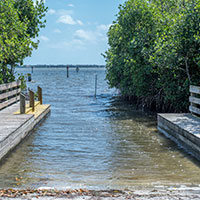 Potentially toxic algae in lagoon at Oslo boat ramp
Potentially toxic algae in lagoon at Oslo boat ramp
STORY BY SUE COCKING (Week of June 17, 2021)
An ugly outbreak of lyngbya, a potentially toxic blue-green algae, has the summer off to an ominous start at the Oslo Road boat ramp.
Arriving at the ramp at the end of a long, narrow shell road in southern Indian River County last Friday with a group of summer camp kayakers, Dr. Richard Baker was shocked by what he saw – large mats of green and white goo blanketing the surface of the shallow lagoon.
“It was awful looking stuff,” said Baker, president of the Pelican Island Audubon Society. “I said, ‘No way we’re going to have our kids going in this.’”
The group turned around, headed back up the shell road and went elsewhere to launch their colorful kayaks.
Baker took photos of the foul-smelling gunk and fired them off to Vero Beach 32963 and other news media and conservation groups, raising the alarm. Researchers from Harbor Branch Oceanographic Institute in Fort Pierce went to the boat ramp and kayak launch and collected samples, then conducted an analysis in the lab of Dr. Amy Wright, head of Harbor Branch’s Center of Excellence in Biomedical and Marine Biotechnology.
The verdict: a cyanobacteria, or blue-green algae called lyngbya, according to Wright’s colleague, research associate Dr. Malcolm McFarland.
“It has the potential to have toxic compounds in it, but we have not measured that,” McFarland said. “People should avoid coming into contact with it if possible. Hopefully, it won’t last long.”
He said lyngbya is known to cause skin irritation if handled.
Potentially toxic algae showing up at the Oslo boat ramp is doubly troubling because the water in that area typically is some of the cleanest in the lagoon.
Baker visited the site on Sunday and observed dark water, but no gunk remaining at the boat ramp. However, he said it was still present at the adjacent kayak launch. He theorized boat traffic may have broken up the mats at the ramp. No warning signs have been posted in the area.
McFarland said lyngbya is native to the Indian River Lagoon and is sometimes observed during the hot, rainy summer months. But he said it’s not usually seen here “in these big, evil-smelling mats.”
“This grows on the bottom. When it gets really abundant, it floats to the surface in these big mats,” he said. “This year, there has been a lot of it.”
Similar to a plant, lyngbya needs nutrients like phosphorus and nitrogen to grow, the scientist added.
The lagoon has been flooded with nutrient pollution in the past decade with chemicals coming from lawn and agriculture fertilizer, leaky septic and sewer systems, and stormwater discharges, causing repeated algae blooms that have degraded the ecosystem.
“We are stimulating their growth,” McFarland said.
With the onset of the rainy season, he said, we may see more of the stuff pop up in various parts of the lagoon.
The algae outbreak at the ramp comes as the Clean Water Coalition of Indian River County, the Indian River Land Trust, the Environmental Learning Center and other environmental groups are urging Gov. Ron DeSantis to declare a state of emergency to restore water quality in the lagoon.



